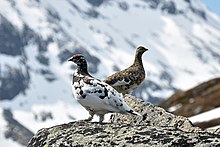Wildlife of Norway

The wildlife of Norway includes the diverse flora and fauna of Norway. The habitats include high mountains, tundras, rivers, lakes, wetlands, sea coast and some lower cultivated land in the south. Mainland Norway has a long coastline, protected by skerries and much dissected by fjords, and the mostly-icebound archipelago of Svalbard lies further north. The flora is very varied and a large range of mammals, birds (many migratory), fish and invertebrate species live here, as well as a few species of reptiles and amphibians.
Geography
Mainland Norway is a mountainous, elongated country with a very long coastline. It extends from a latitude of 58°N to more than 71°N, which is north of the Arctic Circle, and there are some 50,000 smaller islands off the extremely indented coastline. The Scandinavian Mountains extend along the length of the country; the average elevation is 460 m (1,510 ft) and 32% of the mainland is located above the tree line. The mountains end abruptly on the west coast and there is little in the way of a coastal plain. Between the mountains are deep valleys, with lowland largely limited to the southeastern region of the country and the south coast. The far northeast of the country is less mountainous, with rolling hills and the Finnmarksvidda plateau.[1]

Further north still, the archipelago of Svalbard has an arctic climate; the land surface on the three large and many smaller islands is 60% glacier ice, 30% rock and scree, and only 10% is vegetated.[2] The island has its own distinctive flora and fauna.
Climate
The climate of much of the mainland is subarctic, with some continental climate in the southeast and some oceanic climate around the coast. Compared to other places at similar latitudes, the temperature is higher because of the warm North Atlantic Current, and the coast normally remains free of ice.[3] The predominant winds bring relatively warm, humid air in from the Atlantic. Much precipitation falls on the western side of the mountains, with the long inland valleys being rather drier and land to the east of the mountains experiencing a rain shadow effect, with less precipitation, more sunshine and usually warmer summers. The far north and northeast of the country are drier but experience much fog and drizzle.[4]
The climate of Svalbard is dominated by its high latitude, with the average summer temperature at 5 °C (41 °F) and January averages at −14 °C (7 °F).[5] The West Spitsbergen Current moderates Svalbard's temperatures, particularly during winter.
Flora


Vegetation zones in Norway include forests, bogs, wetlands and heaths.
Estimates of the total number of species in the country include 20,000 species of algae, 1,800 species of lichen, 1,050 species of mosses, 2,800 species of vascular plants, and up to 7,000 species of fungi.[8]
In parts of the country with a more continental climate, spruce and pine are dominant and grow at higher elevations than other trees, but in other areas, mountain birch forms the tree line, at around 1,200 m (4,000 ft) in central southeastern Norway, descending to 750 m (2,500 ft) at the Arctic Circle and to sea level further north.[4] At higher altitudes, the terrain is arctic tundra.
Svalbard has permafrost and tundra, with both low, middle and high Arctic vegetation. 165 species of plants have been found on the archipelago.[9] Only those areas which defrost in the summer have vegetation cover and this accounts for about 10% of the island group.
Fauna

Excluding bacteria and viruses but including marine organisms, the total number of animal and plant species in Norway is estimated at 60,000.[8] This includes 16,000 species of insects (probably 4,000 more species yet to be described), 450 species of birds (250 species nesting in Norway), 90 species of mammals, 45 fresh-water species of fish, 150 marine species of fish, 1,000 species of fresh-water invertebrates, and 3,500 species of marine invertebrates.[8]
Terrestrial mammals on mainland Norway include the
Terrestrial carnivores include the brown bear, the Eurasian wolf, the red fox and the Arctic fox, as well as the Eurasian lynx, the European badger, the Eurasian otter, the stoat, the least weasel, the European polecat, the European pine marten and the wolverine. The coast is visited by the walrus and six species of seal, and around thirty species of whale, dolphin and porpoise are found in Norwegian waters.[10]

Norway has a great variety of bird species utilising its many habitats, cliffs, wetlands, forests and tundra. In the summer, insects and other food sources are plentiful and the days are long, giving plenty of time for birds to forage and feed their young. This is not the case in winter when the ground is covered in snow, the wetlands in ice and the days are short, so many of the birds are migratory, usually breeding in Norway and overwintering in southern Europe or Africa.[11]
Six terrestrial species of
There are four terrestrial mammalian species on Svalbard, the
References
- ISBN 0-540-05831-9.
- ISBN 82-7010-167-2.
- ^ Amundsen, Bård; Lie, Else (2 December 2011). "The chaotic current that warms Norway". The Research Council of Norway. Retrieved 13 February 2019.
{{cite web}}: CS1 maint: multiple names: authors list (link) - ^ ISBN 978-3-540-26595-5.
- ^ "Temperaturnormaler for Spitsbergen i perioden 1961–1990" (in Norwegian). Norwegian Meteorological Institute. Archived from the original on 17 July 2012. Retrieved 13 February 2019.
- ISBN 978-1-4381-0527-7.
- ISBN 978-1-4081-3402-3.
- ^ a b c "NOU 2004" (in Norwegian). Regjeringen.no. Archived from the original on 11 May 2008. Retrieved 13 February 2019.
- ^ a b c "Protected Areas in Svalbard" (in Norwegian). Norwegian Directorate for Nature Management. Archived from the original on 27 September 2011. Retrieved 13 February 2019.
- ^ a b "Norsk Zoologisk Forening" (in Norwegian). Sabima. Retrieved 16 February 2019.
- ^ "Norway: Bird migration" (PDF). Fugletrekket. Retrieved 16 February 2019.
- ^ Skei, Jon. "Amphibians and reptiles in Norway - monitoring and research". Council of Europe. Retrieved 16 February 2019.
- PMID 30847088.
